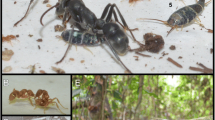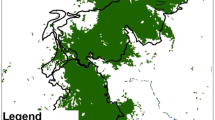Summary
Thievery of food items among colonies of a ponerine ant,Ectatomma ruidum was common; nonnestmates in colonies or near the colony entrances receive incoming food items and carry them to their own colony. In our study area 7 of 10 colonies were victimized by thief ants. Colonies have discrete home ranges and home range size is correlated with the number of workers in the colony. Worker ants discriminate nestmates from non-nestmates when non-nestmates are presented at colony entrances, but individuals from different colonies were not observed to engage in agonistic interactions away from nest entrances. Non-nestmates gain entrance to colonies when the entrance is unguarded. Many instances of non-nestmates being removed from colonies by residents were observed. The costs and benefits of theft under these circumstances are considered.
Similar content being viewed by others
References
Breed MD, Bennett B (1985) Mass recruitment to nectar sources inParaponera clavata: A field study. Ins Soc 33:198–208
Breed MD, Bennett B (1987) Kin recognition in highly eusocial insects. In: Fletcher DJC, Michener CD (eds) Kin recognition in animals. John Wiley & Sons: Chichester, pp 243–285
Breed MD, Fewell JH, Moore AJ, Williams K (1987) Modulated recruitment in a ponerine ant. Behav Ecol Sociobiol 20:407–411
Breed MD, Harrison JF (1988) Individually discriminable trails in a ponerine ant. Ins Soc 34:222–226
Brown WL (1958) Contributions toward a reclassification of the formicidae. II. Tribe Ectatommini. Bull Museum Comp Zool 118 (5):175–362
Carlin NF, Holldobler B (1986) The kin recognition system of carpenter ants I: Hierarachical cues in small colonies. Behav Ecol Sociobiol 19:123–134
Champalbert A (1985) Ethogenese du comportement social et variabilite chez la jeune fourmi primitive Ectatomma tuberculatum. These 3eme cycle, Universite Paris XIII. p 192
Cook OF (1905) The social organization and breeding habits of the cotton-protecting kelep of Guatemala. U.S. Department of Agriculture, Bureau of Entomology, Technical Series No. 10.
Corbara B, Fresneau D, Lachaud JP, Leclerc Y, Goodall G (1986) An automated technique for behavioural investigations of social insects. Behav Proc 13:237–249
Fresneau D, Lachaud JP (1984) Resultats preliminaires sur l'ontogenese d'une societe d'Ectatomma tuberculatum. In: Haro A de, Espalader X (eds) Processes d'acquisition precoce; les communications. Publ. Universitat autonoma de Barcelona and S.F.E.C.A. Barcelona. pp 437–444
Gittleman JL, Harvey PH (1982) Carnivore home-range size, metabolic needs, and ecology. Behav Ecol Sociobiol 10:57–63
Hespenheide HA (1985) Insect visitors to extrafloral nectaries ofByttneria aculeata (Sterculiaceae): relative importance and roles. Ecol Entomol 10:191–204
Holldobler B (1974) Home range orientation and territoriality in harvesting ants,Pogonomyrmex. Proc Natl Acad Sci USA 71:3271–3277
Holldobler B (1979) Territories of the African weaver ant (Oecophylla longinoda): a field study. Z Tierpsychol 51:201–213
Holldobler B (1986) Food rubbing in ants, a form of interference competition. Oecologia 69:12–15
Jaffe K, Marquez M (1987) On agonistic behavior among workers of the ponerine ant Ectatomma ruidum. Ins Soc 34:87–95
Lachaud JP (1984) Mise en evidence d'un recrutement de masse archaique chez une Ponerinae neotropicale:Ectatomma ruidum. Actes coll. Ins Soc 1:107–111
Lachaud JP, Fresneau D (1985) Les premieres etapes de l'ontogenese de la societe chezEctatomma tuberculatum etNeoponera villosa. Actes coll. Ins Soc 2:195–202
Lachaud JP, Valenzuela J, Lopez JA (1982) Observaciones preliminares sobre la importacia deEctatomma ruidum Roger como control de algunos insectos plaga sobre plantas cafe y cacao en el Soconusco. Proc. 10 Reun. nac. contr. biol., Durango (Mexico). pp 76–81
Lachaud JP, Fresneau D, Garcia-Perez J (1984) Etude des strategies d'approvisionnement chez 3 especies de fourmis ponerines. Folia entomologica Mexicana 61:159–177
Levings SC, Franks NR (1982) Patterns of nest dispersion in a tropical ground ant community. Ecology 63:338–344
Levings SC, Traniello JFA (1981) Territoriality, nest dispersion, and community structure in ants. Psyche 88:265–319
Schoener TW (1968) Sizes of feeding territories among birds. Ecology 49:123–141
Ward PS (1983) Genetic relatedness and colony organization in a species complex of ponerine ants. I. Phenotypic and genotypic composition of colonies. Behav Ecol Sociobiol 12:285–299
Weber NA (1946) Two common ponerine ants of possible economic significance, Ectatomma tuberculatum (Olivier) andEctatomma ruidum (Roger). Proc Entomol Soc Wash 48:1–16
Wheeler DE (1986)Ectatomma tuberculatum: foraging biology and association withCrematogaster. Ann Entomol Soc Am 79:300–302
Wilson EO (1971) The insect societies. Harvard University Press, Cambridge, Mass
Yeaton RI, Cody ML (1974) Competitive release in island song sparrow populations. Theor Pop Biol 5:42–58
Author information
Authors and Affiliations
Rights and permissions
About this article
Cite this article
Breed, M.D., Abel, P., Bleuze, T.J. et al. Thievery, home ranges, and nestmate recognition inEctatomma ruidum . Oecologia 84, 117–121 (1990). https://doi.org/10.1007/BF00665604
Received:
Accepted:
Issue Date:
DOI: https://doi.org/10.1007/BF00665604




